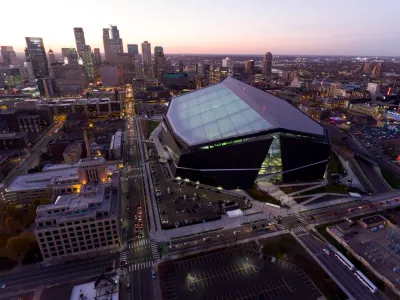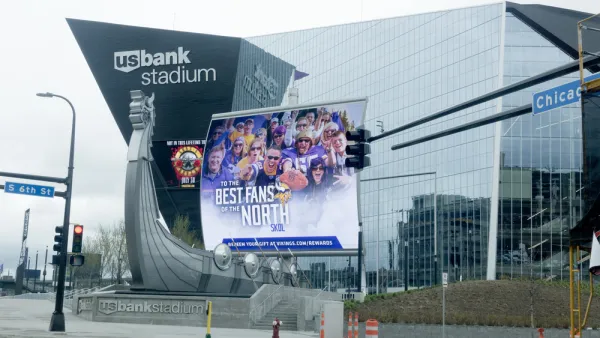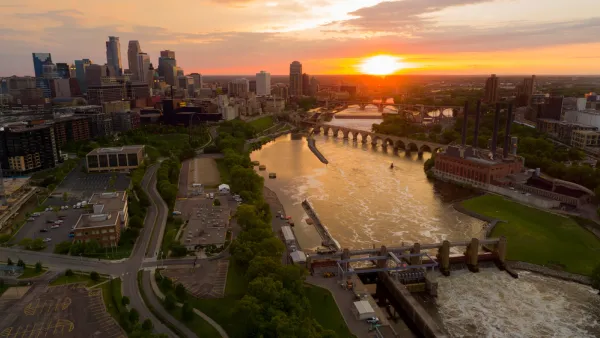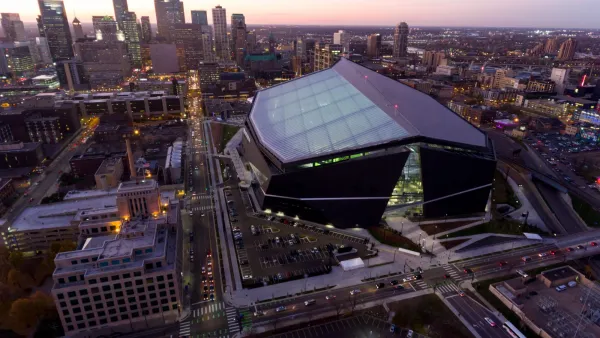Urbanists and planners might consider looking at the development outside U.S. Bank Stadium in Minneapolis on Super Bowl Sunday. Gone are the vast parking lots surrounding the Metrodome, replaced with mixed use and a popular park, the Commons.

"[F]ootball fans returning to the city to watch the New England Patriots and Philadelphia Eagles compete in Super Bowl LII on Feb. 4 are not likely to recognize the area, now known as East Town [formerly Downtown East or East Downtown]," writes freelance journalist, Joe Gose, in the Square Feet column of The New York Times on Jan. 23.
The Metrodome, a walled-in colossus that dominated the barren landscape from 1982 to 2014, has been replaced by U.S. Bank Stadium, which opened in 2016. The roughly $1.1 billion bright and transparent edifice, designed by HKS architects, features a mostly clear, steep roof and has been likened to a Nordic long house, a Viking warship and an ice shard formation.
New offices, apartments, hotels, restaurants and a 4.2-acre park known as the Commons have replaced the parking lots. In all, more than $2 billion in private and public investment has been injected into East Town, according to the East Town Business Partnership, an organization that promotes the roughly 120-block district, which is bordered generally by the Mississippi River, downtown and three interstates.
About five of the original 15 blocks of parking lots still remain, said George Sherman, principal of Sherman Associates, a developer in East Town. “I doubt if there will be any that haven’t been developed in the next two to three years.”
Over half of the original $975 million cost of the stadium came from of state and city funds. Opponents pointed to Metrodome's failure to generate economic development, a reason in itself to avoid providing plentiful parking for stadium events.
The Commons park played a prominent role in encouraging developers to invest in the area.
“When we first looked at the opportunity, we thought there was too much land — there was going to be a great new stadium, but there was nothing to prevent the area from being another sea of surface parking,” said developer Mike Ryan. “But having a major public green space at its core is the reason developers want to be there.”
As for Minneapolis reaping an economic windfall from the game, "economists say its overstated," writes Kevin Draper, a sports business reporter for The New York Times, on Jan. 29.
Getting to the game
East Town and the stadium are served directly by Metro Transit's Blue and Green light rail lines and bus lines, with connecting light rail service from Northstar Commuter Rail. "Ticket holders who buy a $30 'game day' pass will get a nonstop [light rail] ride from a security screening area directly to U.S. Bank Stadium for the game," wrote Sam Newberg, a Minneapolis-based urbanist and Planetizen contributor, on Nov. 19, 2017.
For more reading in Planetizen on the East Town development, see:
-
April 16, 2015, Minneapolis Star TribuneA new park and lots of new development will follow the under-construction stadium for the Vikings on the eastern side of Minneapolis urban core.
-
June 1, 2013, Minneapolis Star TribuneDevelopers have announced plans for 'one of the largest real estate projects in Minneapolis history.' The ambitious proposal for a five block area in the city's downtown east neighborhood could be a catalyst to transform the 'largely barren' area.
FULL STORY: Super Bowl’s Minneapolis Stadium Brings a Surge in Development

Analysis: Cybertruck Fatality Rate Far Exceeds That of Ford Pinto
The Tesla Cybertruck was recalled seven times last year.

National Parks Layoffs Will Cause Communities to Lose Billions
Thousands of essential park workers were laid off this week, just before the busy spring break season.

Retro-silient?: America’s First “Eco-burb,” The Woodlands Turns 50
A master-planned community north of Houston offers lessons on green infrastructure and resilient design, but falls short of its founder’s lofty affordability and walkability goals.

Test News Post 1
This is a summary

Analysis: Cybertruck Fatality Rate Far Exceeds That of Ford Pinto
The Tesla Cybertruck was recalled seven times last year.

Test News Headline 46
Test for the image on the front page.
Urban Design for Planners 1: Software Tools
This six-course series explores essential urban design concepts using open source software and equips planners with the tools they need to participate fully in the urban design process.
Planning for Universal Design
Learn the tools for implementing Universal Design in planning regulations.
EMC Planning Group, Inc.
Planetizen
Planetizen
Mpact (formerly Rail~Volution)
Great Falls Development Authority, Inc.
HUDs Office of Policy Development and Research
NYU Wagner Graduate School of Public Service




























